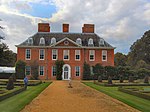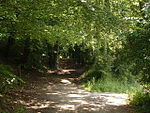Quebec House
Biographical museums in KentBuildings and structures in Sevenoaks DistrictFrench and Indian WarGrade I listed houses in KentHistoric house museums in Kent ... and 5 more
History of Quebec CityHouses completed in the 16th centuryMilitary and war museums in EnglandNational Trust properties in KentWesterham

Quebec House is the birthplace of General James Wolfe on what is now known as Quebec Square in Westerham, Kent, England. The house is listed Grade I on the National Heritage List for England since September 1954.The house dates from the mid 16th century but much of the current appearance is from the 1630s. It was originally called Spiers but renamed in honour of Wolfe's death and victory at the Battle of Quebec in 1759. The house is now owned by the National Trust and open to the public with paintings and memorabilia relating to Wolfe's life.
Excerpt from the Wikipedia article Quebec House (License: CC BY-SA 3.0, Authors, Images).Quebec House
Brasted Road,
Geographical coordinates (GPS) Address Website External links Nearby Places Show on map
Geographical coordinates (GPS)
| Latitude | Longitude |
|---|---|
| N 51.26716 ° | E 0.0759 ° |
Address
Quebec House
Brasted Road
TN16 1TD , Westerham
England, United Kingdom
Open on Google Maps










